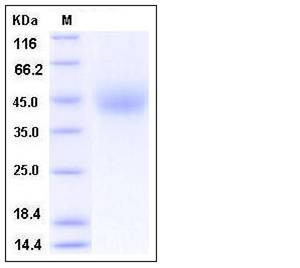Human IL10Rb Protein (His Tag)
CDW210B,CRF2-4,CRFB4,D21S58,D21S66,IL-10R2
- 100ug (NPP3992) Please inquiry
| Catalog Number | P10945-H08H |
|---|---|
| Organism Species | Human |
| Host | Human Cells |
| Synonyms | CDW210B,CRF2-4,CRFB4,D21S58,D21S66,IL-10R2 |
| Molecular Weight | The recombinant human IL10Rβ comprises 212 amino acids and has a predicted molecular mass of 25 kDa. In SDS-PAGE under reducing conditions, the apparent molecular mass of rhIL10Rβ is approximately 45-48 kDa due to glycosylation. |
| predicted N | Met 20 |
| SDS-PAGE |  |
| Purity | > 92 % as determined by SDS-PAGE |
| Protein Construction | A DNA sequence encoding the extracellular domainof human IL10Rβ (NP_000619.3) (Met 1-Ser 220) was expressed, fused with a polyhistidine tag at the C-terminus. |
| Bio-activity | |
| Research Area | Immunology |Inflammation / Inflammatory Mediator |Inflammatory Cytokines & Chemoki and Receptors |IL-10/Interferon Family |
| Formulation | Lyophilized from sterile PBS, pH 7.4 1. Normally 5 % - 8 % trehalose, mannitol and 0.01% Tween80 are added as protectants before lyophilization. Specific concentrations are included in the hardcopy of COA. |
| Background | Interleukin 10 receptor, beta subunit (IL10RB/IL-10RB) also known as Cytokine receptor family 2 member 4, Interleukin-10 receptor subunit 2, and cytokine receptor family II, member 4, is a subunit for the interleukin-10 receptor. IL10RB/IL-10RB belongs to the cytokine receptor family. It is an accessory chain essential for the active interleukin 10 receptor complex. Coexpression of this and IL10RA proteins has been shown to be required for IL10-induced signal transduction. Defects in IL10RB/IL-10RB are the cause of inflammatory bowel disease type 25 (IBD25). It is a chronic, relapsing inflammation of the gastrointestinal tract with a complex etiology. It is subdivided into Crohn disease and ulcerative colitis phenotypes. Crohn disease may affect any part of the gastrointestinal tract from the mouth to the anus, but most frequently it involves the terminal ileum and colon. Bowel inflammation is transmural and discontinuous; it may contain granulomas or be associated with intestinal or perianal fistulas. In contrast, in ulcerative colitis, the inflammation is continuous and limited to rectal and colonic mucosal layers; fistulas and granulomas are not observed. Both diseases include extraintestinal inflammation of the skin, eyes, or joints. |
| Reference |
